
Текст книги "Checkmate (2006)"
Автор книги: David Michaels
Жанр:
Боевики
сообщить о нарушении
Текущая страница: 4 (всего у книги 21 страниц)
8
HEslid the cover back into place, crab-walked four steps to his right, and ducked behind a pallet of crates. Now that the security sweep was over, the dock had returned to normal work lighting. Sodium-vapor lamps hung from cross-girders high in the vaulted ceiling, casting the dock in gray light. Farther down the dock, amid the loading derricks, a group of sailors moved crates around on a hand truck. Here and there he could see the sparkle of welding torches, could smell the sulfer stench of acetylene.
To his right was a familiar sight: the Trego. She was moored bow-first toward the dock door. Her deck hatches, portholes, and windows were covered with yellow plastic sheeting and sealed with red duct tape. At the midships hatch a tentlike structure had been erected—the decontamination entry and exit, he assumed. As he watched, a pair of NEST people in white biohazard suits stepped out of the tent. They were met by a trio of similarly dressed figures who began hosing them down with a foamy liquid.
Fisher felt a flutter in his stomach. Grimsdottir had assured him the radiation levels aboard the Tregowere well below a risky dose, but watching the decontamination procedure made him wary. His harness was fitted with a pen-sized quartz-fiber dosimeter linked to both his subdermal and his OPSAT, so he would get plenty of advance warning if he were taking on a radioactive load. Or so the theory went.
This is why you’re paid the big money, Sam,he told himself.
He scanned the dock and the Tregoin both infrared and night-vision modes until satisfied he knew the positions and movments of all the NEST people, then chose his best route.
Sticking to the shadows, he moved down the dock, heading toward the Trego’s stern. Once he drew even with it, he crept to the edge of the dock, grasped the aft mooring line in both hands, and began shimmying his way over the water. Twice he had to pause as biohazard-suited figures shuffled across the deck and through the decon tent, but at last he reached the railing, swung his legs over, and dropped to the deck in a crouch.
He took two quick steps, mounted a ladder on the superstructure, and started climbing.

HE’Dgotten only ten rungs when he heard the scrape of a boot.
He froze, looked down.
Below him, a NEST person was standing at the rail. The man pulled back his hood and titled his head backward, gulping fresh air. A tinny voice called, “Len, where’re you at?”
The man pulled a portable radio off his belt and replied, “Main deck. Taking a breather.”
“When you’re done, come over to starboard midships. I’ve got a team rotating out. They need a wash down.”
“On my way.”
The man pulled his hood back in place and walked off.
Fisher kept climbing.
ONCEon the superstructure, it took but two minutes for him to find the deck scuttle he was looking for. While a main deck hatch would have provided him a more direct route to the engine room, his penetration of any of the quarantine barriers would not only raise immediate suspicion but also prompt another security sweep.
The scuttle he’d chosen was similarly sealed, but the duct tape separated from the deck’s nonstick coating easily. He turned the wheel and lifted. Inside, a ladder dropped into darkness. He did a quick IR/NV scan, saw nothing, then slipped his legs through the opening and started down. He paused to close the scuttle behind him, then dropped to the deck.
“I’m inside,” Fisher radioed.
Lambert replied, “According the radio transmissions we’ve been monitoring, most of the NEST personnel are in the forward part of the ship. Whatever the radioactive material is, it looks like it’s somewhere in the bow ballast tank. Grim’s updated your OPSAT; the waypoint markers will take you to the engine room.”
“Been there before.”
Grimsdottir said, “I’ve analyzed the paths the dock workers have been taking. My route will skirt those areas.”
Fisher checked his OPSAT. The Trego’s blueprint, shown in a rotatable 3D view, was overlayed with a dotted amber line, starting with his position—shown as a blue square—and ending at the Trego’s engine room—shown as a pink square.
“Got it,” Fisher replied. “Grim, just so we’re clear—”
“You have my word, Sam. The inspectors have to wear those suits. Government regs. Hell, you know better than anyone how persnickety government is. I’ve done the calculations backward and forward. As long as you’re out of there in an hour, you’re fine.”
And at sixty-one minutes?he thought.
Over the years he’d faced every nightmare an operator can imagine, but like most people, radiation held a special, dark place in his mind and heart. Invisible and virtually inescapable, radiation mutated the human body at the core level, destroying and twisting cells in monstrous ways. He’d seen it up close and in person. It was a horrific way to die.
His mind immediately went to Slipstone. If in fact the town’s water supply had been poisoned with some type of radiation, he hated to imagine what the surviving residents were going through: nausea, vomiting, skin burns, hair loss, lungs filling with fluid, accelerated tumor growth. . . .
Eyes on the job, Sam. Deal with what’s in front of you.
The bottom line was he trusted Grimsdottir and Lambert with his life and had done so dozens of times before. He would do so again now. “Okay,” he said. “I’m moving.”
TOavoid interfering with the NEST team’s equipment, the Trego’s generators had been powered down and switched over to the dock’s power grid, so the passageway was darkened, lit only by red emergency lanterns affixed to the bulkhead at ten-foot intervals.
With one eye fixed on the OPSAT and one eye scanning for movement, Fisher padded down the passagway to a T-turn. Right led further aft; left, forward to the bow. He went left. The engine room was eighty feet forward of his position and down three decks. To get there he’d have to navigate five ladders and two deck scuttles.
As he reached the next intersection and started down a ladder, the OPSAT’s screen flickered. The Trego’s blueprint began to pixelize before his eyes. He pressed himself against the bulkhead and got on the radio: “Who forgot to pay the cable bill? My OPSAT’s losing signal.”
“Grim was afraid of that,” Lambert replied. “The NEST people are degaussing.”
Degaussing was a fancy term for demagnetization. Over time, steel-hulled ships pick up a magnetic charge that can interfere with radio and navigation systems. In this case, the charge was making it hard for the NEST inspectors to nail down the signature of whatever material was hidden in the Trego’s ballast tanks, so they were using degaussing emitters.
“Switch to internal,” Grimsdottir said. “You’ll still have the blueprint, but no overlay.”
“No problem,” Fisher said. “I’ll improvise.”
HEreturned to the head of the ladder and drew his SC– 20 from its back holster.
Compact and lightweight, the SC-20 was equipped with a flash/sound suppressor and it fired a standard NATO 5.56mm Bullpup round. That, however, was where similarities to other weapons ended. The SC-20’s modular under-barrel attachment gave Fisher an unprecedented array of options, including a gas/frag/chaff grenade launcher; LTL (Less-Than-Lethal) weapons such as ring airfoil projectiles (RAFs) and sticky shockers; an EM (Electro-Magnetic) pod with a laser-based directional microphone, a signal jammer, and a laser port sniffer for at-a-distance data transfers with IR computer ports; SPs (Surveillance Projectiles) such as a self-adhesive remote camera nicknamed, predictably, a “sticky cam,” and finally a gadget Fisher had dubbed the ASE, or All-Seeing-Eye, a micro-camera embedded in a tiny parachute made from a substance called aero-gel.
Consisting of ninety percent air, aero-gel could hold four thousand times its own weight and had a surface area that boggled the mind: Spread flat, each cubic inch of aero-gel—roughly the size of four nickels stacked atop one another—could cover a football field from end zone to end zone. In the case of the ASE, its palm-sized, self-deploying aero-gel chute could keep the camera aloft for as long as ninety seconds, giving Fisher a high-resolution bird’s-eye view of nearly a square mile.
Unfortunately, tonight, he wasn’t likely to need the ASE; he was hoping he wouldn’t need the SC-20 at all, but then again, ring airfoils and sticky shockers could turn out to be his best tools should he encounter trouble aboard the Trego.
He flipped his NV goggles into place and heard the faint electronic whistle in his earpiece as the they powered up. He scanned the darkened deck below. He saw nothing.
“Proceeding belowdecks,” Fisher radioed.
9
WITHthe SC-20 held at ready-low, Fisher crept down to the next deck, turned the corner, and headed aft. He was halfway down the passageway when he froze. With exaggerated slowness, he crouched down, crab-stepped to the left, and pressed himself against the bulkhead.
Thirty feet down the passageway he’d seen a pencil-eraser-sized red spot on the bulkhead.
Sensor,he thought. But what type? Infrared, motion . . .
The spot moved. Not a sensor. It was the tip of a cigarette. Whether it was a security guard or a NEST person, he couldn’t be sure, but someone was leaning against the bulkhead behind a stanchion, taking an illicit smoke break.
Moving on flat feet, Fisher started easing himself backward.
The figure moved, stepping from behind the stanchion.
Fisher raised the SC-20 and pressed his eye to the scope.
The man was in a white bioharzard suit, the hood tilted back onto his forehead. On his hip was a model– 1911 Colt .45 automatic—standard issue for armed Navy watch personnel.
Other way, sailor. Turn the other way.. . .
The man turned toward Fisher. He went still. His body tensed. He cocked his head, obviously seeing something in the dim light, but not sure what. His hand drifted toward the hip holster.
Fisher fired. The SC-20 coughed, a barely perceptible thwump.
The RAF struck high on the man’s sternum. He crumpled, unconscious before he hit the deck. Fisher trotted forward and knelt down beside the man. He felt for a pulse; it was strong and steady. While classified as an LTL weapon, a ring airfoil projectile had a punch to it, and Fisher had seen it kill men, usually from a lung clot.
He unholstered the guard’s Colt, ejected the magazine, and hid it inside a pipe bundle near the ceiling, then reholstered the gun. If things went to hell, this would be one less gun shooting at him.
He found a dark corner for the guard’s body, covered it with a few scraps of discarded cardboard he found nearby, then pulled the man’s hood back in place and fired a dart into the man’s thigh for good measure.
He doubted he’d need more than the two hours the tranqulizer would buy him, but as with the Colt, if things went to hell, this would be one less guard to deal with.
HEreached the passageway outside the engine room and crouched before the hatch. He switched his goggles to IR, then rose up until he could see through the porthole. Having been powered down for the past eighteen hours, the engine room was a field of dark blue structures broken only by still-warm yellow pipes and the lighter blue outlines of the engines. He saw no one moving about.
He checked his dosimeter reading on the OPSAT: All green. What was the rule with these things? Fisher thought. Green, good; red, dead.
He undogged the hatch and slipped inside.
HEfound the section of catwalk between the engines just as he’d left it: pried back and tossed to one side. The fire hose he’d used to stop the Tregowas also still there, a charred and tangled mass wrapped around the reduction gear. Aside from the ticking of cooling pipes and the occasional hiss of steam, the space was quiet.
He heard the metallic thunkof a hatch opening. He switched his goggles to NV and turned around. A pair of figures in bio-hazard suits were stepping through the hatch.
“. . . I told you: I don’t know why,” said one of the men. His voice was muffled inside the hood. “The boss wants another reading, so we’re getting another reading.” He held up a Geiger counter and panned it through the air; it gave off a steady but slow chirping.
“Yeah, well, this place gives me the creeps.”
“Join the club. Come on, let’s get it done.”
They started down the catwalk, circling the space’s outer bulkhead. Fisher waited until they were out of sight, then reached up, grabbed a pipe, and lifted his legs off the deck and hooked them over the pipe. He reached again, this time snagging the edge of a ceiling I-beam with his fingertips. He rolled himself onto his belly with his thighs and chest resting across the conduits.
Below, he heard the clunk of the men’s footsteps on the catwalk.
The chirp of the Geiger counter grew louder.
Fisher drew his pistol. He thumbed the safety off and switched the selector to DART.
In his peripheral vision, through a tangle of pipes, Fisher caught a glimpse of a biohazard suit coming closer. The men appeared at the head of the catwalk and walked beneath Fisher. They stopped at the open grating. “You have any idea what this is all about?” one man asked.
“Just the rumors. Somebody was in a hurry to stop the ship.”
“Well, hell, I’d say they got the job done. No way they’re going to be able to cut that outa there. That gear is fried, but good.”
“Not our problem.” The man passed the Geiger first over the engines and then the grating, then knelt down and checked the fire hose. The chirping remained steady. “I got nothing. Control, this is Peterson.”
“Go ahead, Pete.”
“Second engine room sweep is done. All clear.”
“Good. Come topside. Time for you to rotate out.”
ONCEthey were gone, Fisher lowered himself back to the deck and slipped feetfirst through the grating. Using the loops in the fire hose as handholds, he lowered himself to the deck, which was ankle-deep in a frothy mix of bilgewater and firefighting foam. The latter had been pumped aboard by the first rescue ship on scene, a Navy destroyer, in hopes of pre-smothering any fires before they had a chance to start. Fire is a ship’s worst enemy, and it was deadlier still aboard a ship carrying hazardous materials.
True to the blueprints, he found the Trego’s twin-diesel engines mounted atop massive dampening springs. Each spring was the size of a fire hydrant and was secured to the deck by bolts as big around as his wrist and as long as his forearm.
As he’d feared, the tightly packed springs made it impossible to wiggle under the engines, so he pulled out his flexi-cam, affixed the telescoping extension, then snaked the lens underneath. He flipped on the cam’s light. The rough metal exterior of the engine casing appeared on the OPSAT’s screen. He started scanning, moving inch by inch.
It took three minutes, but finally the serial number plate came into focus. Fisher steadied the cam and hit the shutter button. He withdrew the cam and tucked it away. He keyed his subdermal, but got only a squelch in return. He looked up. Too much steel overhead.
He climbed back to the catwalk and retraced his steps to the hatch and into the passageway. He keyed his subdermal again. “I’m out. Got the numbers.”
“Good work,” Lambert said. “Change of plans. Go to Extraction Point Bravo.”
Extraction Point Bravo was the designated emergency pickup.
“What’s happened?” Fisher asked.
“We think we know what happened to the rest of the Trego’s crew.”
10
THIRD ECHELON SITUATION ROOM
THEsatellite feed had been siphoned from a commerical LANDSAT by an NSA picket station, so the angle was heavily oblique and the colors faded, but there was no mistaking the single ship in the middle of the plasma screen.
“The Trego, I presume?” Fisher said.
“The one and only,” Lambert replied. “Two hundred miles off the coast of Virginia the morning before your encounter with her. Okay, go ahead, Grim.”
Sitting at the other end of the conference table, Grimsdottir tapped a few keys on her laptop and the image changed. A second ship, clearly smaller than the Trego,appeared in the upper left-hand corner of the screen. “Now we move ahead thirty minutes. Note the Trego’s wake has disappeared. She’s sitting dead in the water.” She tapped the keyboard again. “Ahead forty-two minutes.”
The Tregoand the second ship were sitting next to one another.
“Ahead twelve minutes. Zooming in.”
The image flickered, then zoomed in until the two ships filled the screen. In the water between them Fisher could make out what looked like a Zodiac raft.
“The whole operation took twenty-two minutes,” Lambert said. “The Zodiac goes over to the Tregowith one man aboard. Nineteen minutes it comes back with nine more men.”
“The Trego’s crew minus one,” Fisher said.
“Right. We’re guessing the intervening time was used to set up the automation system.”
“And to draw straws to see who stays behind. Speaking of which, anything from our prisoner?”
“Still not talking,” Lambert said.
Shortly after the man had woken up handcuffed to a bed in Third Echelon’s medical bay, Redding had begun questioning him. It was another tidbit Fisher didn’t know about Redding: He was in fact a Marine Corps-trained interrogator.
“We’re turning him over to the FBI; let them take a crack at him. Okay, back to the Trego. Here’s what we know: Ten minutes after the Trego’s crew boards the mystery ship, they both get under way and part company, the Tregoheading west toward the Atlantic Seaboard, the other ship heading south.”
“Please tell me we know more than that.”
Grimsdottir tapped some more keys. Another satellite image appeared. “Welcome to the harbor at Freeport City, Bahamas. Check the center-right of screen. Behold our mystery ship: the oceangoing yacht Duroc. She’s been anchored there since yesterday. I’m working on the registration.”
Fisher stared at the yacht for a few seconds, then turned to Lambert. “When do I leave?”
THIRDEchelon maintained a private airstrip outside Hanover, eight miles northeast of NSA headquarters. It was just past one in the morning when Fisher pulled his car onto to the tarmac beside a Boeing V-22 Osprey.
The Osprey was Third Echelon’s workhorse, used for insertion and extraction missions. Billed as a half-helicopter, half-turboprop aircraft, the Osprey had twin engines, each one mounted on a rotatable nacelle, combining the maneuverability and vertical takeoff capability of a helicopter and the high speed and altitude limits of a standard airplane.
The Osprey’s rotors were already spinning at idle. Through the lighted cockpit window Fisher could see the pilot, Bird, and his copilot, Sandy, going through the preflight. Bird was a typical Southern boy, with an awshucks drawl and a carefree personality to match. Sandy, on the other hand, was all business, one of the first women to break into the typically male-dominated special operations community.
Fisher gathered his duffel bag from the trunk and walked to the rear ramp. He was surprised to see Redding standing at the bottom.
“Didn’t know I was going to have company,” Fisher said.
“I wasn’t getting anywhere with our prisoner, so I thought I’d come keep you out of trouble.”
“Will, getting into trouble is what I do for a living.”
“How nice for you. I’ve got some new gear for you. Come on, we’ve got some air to cover.”
ONCEthey were airborne and heading south, Redding pulled a black duffel bag from the overhead bin and dropped it on the floor between their seats. Fisher’s standard equipment load-out was maintained in several places, the Osprey one of them. Fisher assumed that whatever was in this duffel was brand-new.
Redding unzipped it and pulled out a familiar item: Fisher’s tactical suit, a one-piece black coverall fitted with the various pouches, pockets, and harness attachments needed to carry all his equipment. Fisher could see immediately this tac-suit was different.
“First and most important,” Redding said, “you’re familiar with Dragon Skin?”
Fisher was. Originally developed by Pinnacle Armor, Dragon Skin was the world’s first “move when you move” body armor. Lightweight and flexible, Dragon Skin could stop bullets as heavy as an AK-47’s 7.62mm. For years DARPA had been working with Dragon Skin-like composites for special operators, but hadn’t been able to decrease the weight enough to make it feasible.
“DARPA’s figured it out,” Fisher said.
Redding nodded. “Meet the Mark V Tactical Operations Suit, code-named RhinoPlate. Weight, four pounds unloaded; thickness, eight millimeters—about a quarter inch. Outer shell is Kevlar; core material RhinoPlate; inner layer is seventh-generation Gore-tex.”
“Stats?”
“Good against shrapnel at twelve feet; rifle rounds at fifteen; pistol and shotgun at eight feet. The Gore-Tex is tested to maintain core body temperatures down to fifteen degrees Fahrenheit with the hood up, and as high as one hundred ten. You could go from Alaska to the Sahara and stay relatively comfortable.”
“The color’s different.”
“Good eye. New camouflage. The outer layer of the Kevlar is treated with a polymer fiber similar to the coating on stealth aircraft: matte-black, slightly rough to the touch for maximum light absorption. I won’t bore you with the physics, but the micro-roughened exterior partially defuses light. Basically, about thirty percent of whatever photons strike the surface gets trapped—if for only a split second—but enough to diffuse them. Bottom line: You stand still in a shadow, you’re virtually part of the shadow.”
“And the pouches and harness points? Everything’s moved. It looks . . . lumpy.”
“Disruptive patterning. We’ve resized and rearranged them to break up your form.”
Mother Nature abhors straight lines. In low-light conditions the human eye tends to seek out movement, color difference, and geometric form. Of the three, movement was the easiest to address: stand still. Color difference was also easy: Black gives the eye little to draw from the background. Form, however, was problematic. The human body is a unique collection of angles and lines easily discernible to the human eye. By rearranging the pouches to various spots on the suit, the familiar outline of the body becomes fuzzy.
Fisher took the suit from Redding and examined it. He nodded. “I like it. One question.”
“What?”
“Where do I put my car keys?”
“ OKAY,one more item,” Redding said. “An add-on to the SC-20. Again, I’ll spare you the technical stuff. We’ve nicknamed it Cottonball.” He handed Fisher two items: what looked like a standard shotgun shell, and a spiked soft rubber ball roughly the size of marble. “The basic firing mechanism is the same as the sticky shocker and ring airfoil, but with a big difference. Once it’s out of the barrel, the sabot breakes away, leaving only the Cottonball. When it strikes a hard object, an inner pod of aerosol tranquilizer is released. The cloud radius is three feet. Anyone inside that will be unconscious in three or four seconds.”
“Impressive. Duration?”
“For a hundred-eighty-pound man, a waist-up strike will give you about twenty minutes.”
“Accuracy?”
“Plus or minus six inches over fifty feet.”
Bird’s voice came over the intercom: “Hey, boys, incoming transmission for you.”
Fisher tapped his subdermal. “Go ahead,” Fisher said.
Lambert’s voice: “Your target’s gone mobile, Fisher. The Durocjust lifted anchor; she’s steaming northeast out of Freeport City harbor.”
“Destination?”
“Working on it, but we’ve confirmed she took on provisions the day before, including fuel.”
“Probably not a day trip, then. So we either wait for her to put in somewhere, or intercept her under way.”
On headphones, Redding said, “Uh, Colonel, we’ve got a full load-out onboard. I was thinking . . .”
“Skipjack?”
“Skipjack.”
Fisher groaned. “Ah, man, I hate the Skipjack.”








